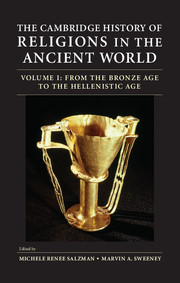Book contents
- Frontmatter
- Contents
- List of Figures and Maps
- List of Contributors
- List of Abbreviations
- Acknowledgments
- Introduction to Volumes I and II
- Introduction to Volume I
- Part I Mesopotamia and the Near East
- Part II Egypt and North Africa
- Part III Greece and the Eastern Mediterranean
- Part IV The Western Mediterranean and Europe
- Suggestions for Further Reading
- General Index
- Index of Citations
- Frontmatter
- Contents
- List of Figures and Maps
- List of Contributors
- List of Abbreviations
- Introduction to Volume II
- Part I Iran and the Near East
- 1 Religion in Iran
- 2 Creating Local Religious Identities in the Roman Near East
- 3 Judaism in Palestine in the Hellenistic-Roman Periods
- 4 Post-70 Judaism in Judea and the Near East
- 5 Christianity in Syria
- Part II Egypt and North Africa
- Part III Greece and Asia Minor
- Part IV Italy, Roman Gaul, and Spain
- Suggestions for Further Reading
- General Index
- Index of Citations
- References
3 - Judaism in Palestine in the Hellenistic-Roman Periods
from Part I - Iran and the Near East
Published online by Cambridge University Press: 05 October 2013
- Frontmatter
- Contents
- List of Figures and Maps
- List of Contributors
- List of Abbreviations
- Acknowledgments
- Introduction to Volumes I and II
- Introduction to Volume I
- Part I Mesopotamia and the Near East
- Part II Egypt and North Africa
- Part III Greece and the Eastern Mediterranean
- Part IV The Western Mediterranean and Europe
- Suggestions for Further Reading
- General Index
- Index of Citations
- Frontmatter
- Contents
- List of Figures and Maps
- List of Contributors
- List of Abbreviations
- Introduction to Volume II
- Part I Iran and the Near East
- 1 Religion in Iran
- 2 Creating Local Religious Identities in the Roman Near East
- 3 Judaism in Palestine in the Hellenistic-Roman Periods
- 4 Post-70 Judaism in Judea and the Near East
- 5 Christianity in Syria
- Part II Egypt and North Africa
- Part III Greece and Asia Minor
- Part IV Italy, Roman Gaul, and Spain
- Suggestions for Further Reading
- General Index
- Index of Citations
- References
Summary
The “Dark Ages” of the Fourth and Third Centuries Bce
Although Alexander the Great’s conquest of the Near East was a turning point in the region’s history, Jewish historiography rarely marks this event as the beginning of a new era. The fourth (still mainly Achaemenid) and third (Ptolemaic) centuries are grouped together, bounded at their beginning by Ezra and Nehemiah and at their end by the Seleucid conquest of Judea (198 BCE). The reason for this neglect of Alexander’s conquest is the darkness that shrouds Judaism in the fourth and third centuries.
Flavius Josephus provides little information about these two centuries apart from one document dealing with the Transjordanian Jewish principality ruled by the Tobiads in the third century (Ant. 12.4.157–236). From him, we learn that they intermarried with the aristocracies of Judea and Samaria, and that members of the Tobiad family, familiars at the Ptolemaic court, bid for and bought from the Ptolemies in Alexandria the right to farm the taxes of Judea. Information from the Zeno papyri intersects with Josephus. Zeno, the business manager of Apollonius, a financial minister of Ptolemy II Philadelphus, traveled in Syria and Palestine and traded with the Tobiads. An inscription from the fifth century BCE and the last verses of Nehemiah also mention the Tobiads.
- Type
- Chapter
- Information
- The Cambridge History of Religions in the Ancient World , pp. 87 - 115Publisher: Cambridge University PressPrint publication year: 2013



